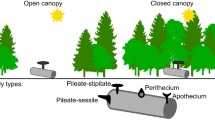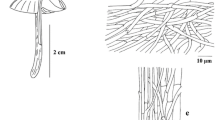Abstract
With an increasing interest in the use of selected fungi for the production of sheathing (ecto-) mycorrhizas by controlled inoculations, attempts were made to identify collections ofLaccaria fruitbodies from woodland and forest sites in central Scotland and at high altitudes in southern India.
Although the sizes of individual fruitbodies within collections varied appreciably, it was nonetheless possible to sort the collections into 2 groups using mean sizes: one group with (i) stipes (stalks) about 7 mm long and 1 mm diam. and (ii) pilei (caps) 10 mm diam., and a second group with appreciably larger fruitbodies.
The group of larger fruitbodies was found to contain collections with either 2- or 4-spored basidia; the basidia in the group of small fruitbodies were all 2-spored.
Although of similar sizes, spores of the 4-spored specimens had different shapes as judged by the ratios (Q values) of spore length: spore width, separately assessed for each spore with its apiculus in view. They were either globose (Q=1·01) with 8·6 spines per 9 μm2, each spine being on average 1·01 μm tall—a description conforming toLaccaria laccata (Scop.: Fr.) Bk. and Br- or elliptical (Q=1·20) with 16·3 spines per 9 μm2, each spine being only 0·72 μm tall—a description conforming toLaccaria proxima (Boud.) Pat.
The spores of the group of large fruitbodies with 2-spored basidia were globose, like those ofLaccaria laccata, but slightly larger and with more spines per unit area, 11·3 per 9 μm2, a description conforming toLaccaria ohiensis (Mont.) Sing. The spores of the group of small fruitbodies with 2-spored basidia were similarly globose but, in contrast, were appreciably larger, 10·1×9·6 μm (compared with 6·3×6·3 μm forL. laccata), with taller (1·91 μm) and fewer spines, 4·2 per 9 μm2, a description conforming toLaccaria tortilis (Bolt.) S. F. Gray.
Laccaria laccata, Laccaria proxima andLaccaria tortilis were collected in Scotland;Laccaria proxima andLaccaria ohiensis in India. Contrary to expectationLaccaria laccata was found less frequently thanLaccaria proxima, the fruitbodies of both being sometimes outnumbered by those ofLaccaria tortilis in young stands ofBetula spp.
Similar content being viewed by others
References
Berkeley M J and Broome C E 1883 Notices of British fungi;Annals and Magazine of Natural History V 12 370–374
Björkman E 1942 Uber die bedingungen der mykorrhizabildung bei keifer und fichte;Symb. Bot. Ups. 6 1–191
Boudier E 1881 Nouvelles espèces de champignons de France;Bull. Soc. Bot. Fr. 28 91–98
Cooke M C 1884 New British fungi;Grevillea 12 65–70
Deacon J W, Donaldson S J and Last F T 1983 Sequences and interactions of mycorrhizal fungi on birch;Plant Soil 71 257–262
Fries E 1821Systema Mycologicum (E. Mauritius: Gryphiswald)1 p. 238
Lange J E 1935Flora Agaricina Danica (Copenhagen: Soc. Adv. Mycol., Denmark)1 p. 96
Last F T, Mason P A and Wilson J 1983 Fine roots and sheathing mycorrhizas: their formation, function and dynamics;Plant Soil 71 9–21
Last F T, Mason P A, Pelham J and Ingleby K 1984 Fruitbody production by sheathing mycorrhizal fungi: effects of ‘host’ genotypes and propagating soils;For. Ecol. Manage. 9 221–227
McNabb R F R 1972 The Tricholomataceae of New Zealand. ILaccaria Berk. and Br.;N. Z. J. Bot. 10 461–484
Maire R 1908 Session générale d’Octobre 1907 et notes critiques sur quelques espèces récoltées pendant la session;Bull. Soc. Mycol. Fr. 24 25–61
Malençon G 1966Laccaria laterita n sp, espèce thermophile;Bull. Trimest. Soc. Mycol. Fr. 82 181–189
Marx D H 1980 Ectomycorrhizal fungus inoculations: a tool for improving forestation practices, inTropical Mycorrhiza Research (ed.) P Mikola (Oxford: Clarendon Press)
Mason P A, Last F T, Pelham J and Ingleby K 1982 Ecology of some fungi associated with an ageing stand of birches (Betula pendula andB. pubescens);For. Ecol. Manage. 4 19–39
Mason P A, Wilson J, Last F T and Walker C 1983 The concept of succession in relation to the spread of sheathing mycorrhizal fungi on inoculated tree seedlings growing in unsterile soils;Plant Soil 71 247–256
Melin E 1923 Experimentelle untersuchungen über die Birken- und Espen-mykorrhizen und ihre pilzsymbionten;Sven. Bot. Tidskr. 17 479–520
Miller O K, Laursen G A and Farr D F 1982 Notes on Agaricales from Arctic Tundra in Alaska;Mycologia 74 576–591
Miler O K 1983 Ectomycorrhizae in the Agaricales and Gasteromycetes;Can. J. Bot. 61 909–916
Molina R 1982 Use of the ectomycorrhizal fungusLaccaria laccata in forestry 1. Consistency between isolates in effective colonization of containerized conifer seedlings;Can. J. For. Res. 12 469–473
Möller F H 1945Fungi of the Faeroes I Basidiomycetes; (Copenhagen: Munksgaard) p 295
Moser M 1978Basidiomycetes II Röhrlinge und Blätterpilze; 4Auflage (Stuttgart: Verlag) p 535
Mueller G M and Sundberg W J 1981 A floristic study ofLaccaria (Agaricales) in Southern Illinois;Nova Hedwigia Z. Kryptogamenkd. 34 577–597
Mueller G M 1985 Numerical taxonomic analyses onLaccaria (Agaricales);Mycologia 77 121–129
Natarajan K 1977 South Indian Agaricales III;Kavaka 5 35–39
Orton P D 1960 New check list of British agarics and boleti Part III Notes on genera and species in the list;Trans. Br. Mycol. Soc. 43 159–439
Patouillard N 1887Les Hymenomycetes D’Europe; anatomie générale et classification des champignons superieurs; (Paris: Librairie Paul Klinchsieck) p 166
Rayner R W 1979 The frequencies with which basidiomycete species, other than rusts and smuts, have been recorded on B. M. S. forays;Bull. Br. Mycol. Soc. 13 110–125
Rea C B 1922British Basidiomycetae (Cambridge: University Press) p 799
Scopoli I A 1772Flora Carniolica Exhiberis Plantas Carnioliae Indigenas et distributas in classes, genera, species varietates ordine Linnaeano Tomes II; (Vindobonensis: Krauss) p 496
Singer R 1967 Notes sur le genreLaccaria;Bull. Soc. Mycol. Fr. 83 104–123
Singer R 1975The Agaricales in Modern Taxonomy 3rd edition; (Vaduz; Cramer) p 912
Author information
Authors and Affiliations
Rights and permissions
About this article
Cite this article
Irving, F., Crossley, A., Mason, P.A. et al. Characteristics of some species ofLaccaria, a fungal genus of significance to forestry, temperate and tropical. Proc. Indian Acad. Sci. 95, 321–331 (1985). https://doi.org/10.1007/BF03053243
Received:
Issue Date:
DOI: https://doi.org/10.1007/BF03053243




